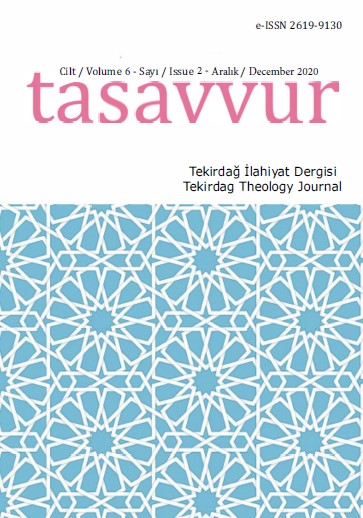Muhammed b. Yûsuf es-Semerkandî’nin Fetḥu’l-ġalak fi’t-tevḥîd Adlı Eseri: Değerlendirme ve Tenkitli Neşir
Nāṣir al-Dīn al-Samarqandī’s Fatḥ al-ghalaq fī al-tawḥīd: Critical Edition and Evaluation
Author(s): Özkan Şimşek, Yusuf ArikanerSubject(s): Review, Islam studies, Other Language Literature, 6th to 12th Centuries, Hermeneutics
Published by: Tekirdağ Namık Kemal Üniversitesi İlahiyat Fakültesi
Keywords: Kalām; Māturīdiyya; Mutashābih; Taʾwīl; Nāṣir al-Dīn al-Samarqandī; Fatḥ al-ghalaq fī al-tawḥīd;
Summary/Abstract: There have been fundamental debates in the tradition of Kalām regarding how to understand the allegorical and ambiguous expressions (mutashābih) expressions that are mentioned both in the Qurʾān and ḥadīths. Many scholars who are of different orientations and schools are known to have written a number of works on the issue at stake. One of whom is a Māturīdī scholar, Abū al-Qāsim Nāṣir al-Dīn Muḥammad b. Yūsuf al-Ḥasanī al-Madanī al-Samarqandī (d.556/1161), critical edition of whose work entitled as Fatḥ al-ghalaq fī al-tawḥīd is presented in this study. His extant Arabic manuscript is conserved at the library of Süleymaniye, in the collection of Fatih, under the heading number 3142. The work’s distinguishing characteristic is that it is the only known extant work within the Māturīdī theological school. The author of the mentioned work is of the opinion that taʾwīl shall be conducted within certain principles that are drawn both from Qurʾān and reason together. And especially by abiding the principle that one should not digress the linguistic meaning and hence he should attribute mutashābih expressions to muḥkam again abiding by the same principles. At this point, he goes on to criticize taʾwīl methods of both Bāṭinis and Ḥanbalīs, whose engagements with taʾwīl run against the frame the author had drawn previously and therefore he see them as representing the edges in the issue at stake. In addition to revealing the approach of the Ḥanafī-Māturīdī tradition, as a late period work, the book under study offers a rich and informative content about the interpretation of the statements discussed in this subject, and provides a holistic understanding of the mutashābih. Within the scope of this study, a brief introduction to mutashābih, life and works of al-Samarqandī and a critical edition of his book are to be presented to the attention of researchers.
Journal: Tasavvur Tekirdağ İlahiyat Dergisi
- Issue Year: 6/2020
- Issue No: 2
- Page Range: 1329-1397
- Page Count: 69
- Language: Turkish, Arabic

